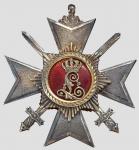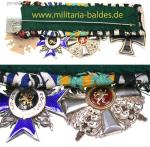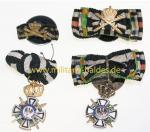-
Posts
4,908 -
Joined
-
Last visited
-
Days Won
97
Content Type
Profiles
Forums
Blogs
Gallery
Events
Store
Everything posted by Dave Danner
-
Catalog description: Los Nr. 3141 Auszeichnungs- und Dokumentengruppe Oberst Hans Nuyken Achtteilige Ordensschnalle in der 57er Trageweise mit Preußen: Eisernes Kreuz 1914, 2. Klasse, Lippe-Detmold: Ehrenkreuz 4. Klasse mit Schwertern, Deutsches Reich: Ehrenkreuz für Frontkämpfer 1934, Lippe-Detmold: Kriegsverdienstkreuz für Kämpfer, Hansestadt Hamburg: Hanseatenkreuz, Deutsches Reich: Kriegsverdienstkreuz 2. Klasse mit Schwertern, Wehrmachts-Dienstauszeichnung 3. und 4. Stufe für 12 und 4 Jahre. Dazu die passende Feldschnalle und eine Miniaturnadel des preußischen Kadettenkorps, Eisernes Kreuz 1914, 1. Klasse, Lippe-Detmold: Kriegsehrenkreuz für heldenmütige Tat, Kriegsverdienstkreuz 1. Klasse mit Schwertern 1939, Verwundetenabzeichen in Schwarz 1918 und diverse Kriegerbund-Mitgliedschaftsnadeln. Die Dekorationen des Zweiten Weltkrieges und die beiden EK in der 1957er Ausführung. Das an der Ordensschnalle befindliche Ehrenkreuz 4. Klasse mit Schwertern in der Fertigung der Firma C.F. Zimmermann Pforzheim ist mit einer Gesamtverleihungszahl von 82 Exemplaren besonders selten. Im beiliegenden Wehrpass sind seine Auszeichnungen und der "Kaiserdegen 1912" (nachfolgendes Los) eingetragen. Dazu vier Fotografien aus der Zeit des Zweiten Weltkrieges und Zeitungsberichte zu Nuykens 75. und 85. Geburtstag mit angelegter Ordensschnalle bzw. Berichterstattung über seinen "Kaisersäbel". Oberst Hans H. Nuyken, geboren am 8. Juni 1890 in Biberach, erhielt nach Absolvierung des Kadettenkorps sein Leutnantspatent 1911, diente im Ersten Weltkrieg an den Fronten in Ost und West und war bis 1945 Bonns und Siegburgs letzter Wehrbezirkskommandant. Seine Stammeinheit war das 6. Westfälische Infanterie-Regiment "Graf Bülow von Dennewitz" Nr. 55, welches zum Teil durch den Staat Lippe gestellt wurde. Als bester Schütze des westfälischen Offizierskorps erhielt Nuyken vom Kaiser 1912 den Schießpreisdegen verliehen. Zustand: II Limit: 1600 EURO Zuschlag 1900 EURO Also close-ups of the Ehrenkreuz:
-
You wouldn't necessarily have to go all the way back to 1891, the last qualifying year for Indian Campaign Medal. For example, the 9th Infantry Regiment was in the Siege of Santiago de Cuba in June/July 1898, and subsequently was sent to the Philippines, and from there to China. Depending on when he left Cuba (qualifying period was 18 July 1898 - 20 May 1902), someone with that regiment could have gotten the Spanish, China and Philippine Campaign Medals and the Cuban Pacification Medal. And that's not counting society awards like the medal of the Society of the Army of Santiago de Cuba.
-
Regarding the Fürstich Schwarzburgische Ehrenmedaille in Silber: I only have a roll for these from 1909 to 1918, as they started a new roll after the childless Fürst Karl Günther von Schwarzburg-Sondershausen died and Fürst Günther Victor von Schwarzburg-Rudolstadt succeeded him, reuniting the two principalities in personal union. This roll covers both civilian and military awards of the Friedensklasse. There weren't any wartime military awards of the Ehrenmedaille, as the Medaille für Verdienst im Kriege was awarded instead. But civilians continued to receive the medal. There were also wartime awards for homefront merit with the oak brooch (Eichenbruch "1914/15"), but the roll from Rudolstadt for these is missing. Between April 1909 and November 1918, there were 141 awards of the Ehrenmedaille in Gold and 432 awards of the Ehrenmedaille in Silber. Just looking at the first year, which may give you an idea of how many awards were made in peacetime, there were the following between 17.4.1909 and 17.4.1910: Inf. Regt. Nr. 71 - 24 (2 Fw., 8 Vfw., 2 Sgt., 4 Uffz., 1 Gefr., 6 Musk., 1Tambour) III./Inf. Regt. Nr. 96 - 7 (1 Fw., 1 San.Fw., 3 Vfw., 2 Sgt.) Schutztruppe - 2 (1 Fw., 1 Gefr.) Other military - 3 to Bezirksfeldwebel (1 in Rudolstadt and 2 in Sondershausen), 1 to a Sanitäts-Feldwebel in Sondershausen, although I am not sure if the latter was military, as no unit is given. Were there police or other Sanitäts-Feldwebel? The Ehrenmedaille in Silber was often given to military men as a long service & good conduct medal after 12 years of service, although as can be seen with the awards to Musketiers, it was also probably given as an individual merit medal.
-
"überweisen" is OK. It is basically between "versetzt" and "kommandiert". I see it all the time in Wehrmacht files where an officer was commanded to a particular assignment, and in the meantime transferred from one command to another, while remaining in his commandment (that doesn't sound right in English, shades of Moses). For example, "Lt. in GR 12, in das GR 11 versetzt, zur Fliegertruppe kommandiert, dem GR 12 überweisen..." would mean he returned from GR 11 to GR 12 as his permanent station, but remained attached to an aviation unit.
-
OK, To recap the process, first, I eliminated all the recipients of the Militärischer Karl-Friedrich-Verdienstorden who had other known ribbon awards, especially the Order of the Zähringen Lion with Swords. This eliminated the vast majority, since more than 90% of MKFVO recipients had the Zähringen Lion. There's no way to check the HT and SLK, but with only about 20 names, I figured the Anhalt rolls would narrow down the field. And it did. Only one name showed up, although oddly twice. First, in 1915, as an Obersleutnant and Chief of the General Staff of the IV.Armeekorps, and then around 1917 (no exact dates in the rolls) as Oberst and Abteilungschef in the Kriegsministerium. Apparently, someone in Dessau didn't realize that Oberstleutnant Johann was the same person as Oberst Hans. That might be a common error if your name was something common like Hans or Johann Schmidt, but odd if your name was.... Johann (Hans) Emil Friedrich Ritter und Edler von Braun * 24.6.1867 in Sinsheim, Baden † xx.xx.1938 Prior to mobilization, he was an Abteilungschef in the Kriegsministerium. He received the MKFVO on 30 October 1914 as commander of Res.-Inf.-Regt. Nr. 13, which he had taken over on mobilization. He then became Chief of the General Staff of the IV.Armeekorps, which included Anhalt's IR 93. He was promoted to Oberst in July 1915 and returned to the Kriegsministerium in October 1915, remaining there for the rest of the war. Generalmajor in 1918, he was retained in the Reichswehr, serving as Chief of the Personalamt from 1919 to 1922. He was apparently, along with Hans von Seeckt, responsible for making sure the officer corps of the 100,000-man Reichswehr was stacked with former General Staff officers, on the belief that their skills would make easier any future expansion of the army. He retired in 1922 as a Generalleutnant. He had a longgggg list of peacetime awards, mainly from 1908 to 1912, when he was Flügeladjutant to the Großherzog von Baden. This would have added at least a dozen more ribbons, so a "wartime-only" ribbon bar makes some sense. Entry from the 1914 Rangliste: From 1912 to 1913, he was a battalion commander in IR 117, which might explain the Hessen bravery medal. RIR 13 was a Westphalian regiment, which might account for the Schaumburg-Lippe cross. Besides the Iron Cross 1st and 2nd Class, other known wartime awards are the Prussian Crown Order 2nd Class with Swords, gazetted on 19.7.17, and the Württemberg Friedrich-Orden, Commander 2nd Class with Swords. I mistakenly had him with a Bavarian MVO Officer's Cross with Swords on my old MKFVO list, but that should have been Julius Ritter von Braun. As I said above, the ribbon bar would have to be from before mid-1918, since he received the Lübeck Hanseatenkreuz on 26 June 1918. If I had to guess, I would say the ribbon bar probably dates from his return to Berlin in late 1915 and includes the war awards he received in the opening campaigns of the war. Here are the rest of the career details I have for him: 1.10.85 als Einj.Frw. i.d. IR 113 eingetreten 13.5.86 Port.-Fähnr. 15.1.87 Sekonde-Lieutenant 19.12.93 Premier-Lieutenant 1.4.98 k.z. Dienstl. beim Gr.Gen.St. 29.3.00 unter Beförderung zum Hauptmann i.d. Gr.Gen.St. versetzt 10.5.01 i.d. Gen.St. d. X.Armeekorps versetzt 17.2.03 als Kp.Chef i.d IR 21 versetzt 18.10.04 i.d. Gen.St.d.Armee versetzt 1.3.06 k.z. Dienstl. b. Kr. Min. 12.4.06 i.d. Kr.Min. versetzt 27.1.07 Major 21.7.08 zum Flügeladj. S.K.H. d. Großherzogs von Baden ernannt 22.3.12 i.d. IR 117 versetzt u. zum Btl.Kdr. ernannt 16.6.13 Oberstleutnant 1.10.13 k.z. Dienstl. b. Kr. Min., Abt.Chef, Ersatzwesen-Abteilung, Allg. Kriegs-Dept. 30.5.14 i.d. Kr.Min. versetzt 2.8.14 Kdr. RIR 13 xx.xx.14/15 Ch.d.Gen.St. d. IV.Armeekorps 24.7.15 Oberst 15.10.15 Oberst v.d. Armee und k.z. Dienstl. b. Kr. Min., z.b.V. in d. Kr.Min. versetzt. 19.1.16 Chef d. Kriegsersatz- u. Arbeits-Department 1.11.16 Chef d. Kriegsersatzamt, Kriegsamt 20.9.18 Generalmajor 1.10.19 Chef d. Personalamts xx.xx.21 Generalleutnant 31.3.22 Abschied Unfortunately, he went with the modest "no decorations" look in his post-war photo which appears in the book "Die Führer des Reichsheeres 1921 - 1931":
-
I have four more names to check if they can be ruled out, but I have a potential candidate. Native Badener, served at least at one point in a Hessen regiment, wandering staff career. For it to be him, though, at least two things must be true: one, the ribbon bar is a "wartime awards" only bar, and two, the ribbon bar is from before mid-1918, when he would have added another award not present here. Also, the Anhalt/Baden/Hessen/Schaumburg-Lippe combination is less weird if you know that he also had awards from a few other German states, but they were worn on the chest or around the neck. I guess a third thing must be true too: he can't also have had any awards at the time the bar was made from other states for which we don't have rolls, such as Bremen, Hamburg or Oldenburg.
-
I made some copies of Sascha's image and cropped them. Let's hope these don't get shrunk too much. http://gmic.co.uk/uploads/monthly_08_2013/post-432-0-90155800-1377188719.jpghttp://gmic.co.uk/uploads/monthly_08_2013/post-432-0-44084500-1377188730.jpg http://gmic.co.uk/uploads/monthly_08_2013/post-432-0-14752400-1377188740.jpghttp://gmic.co.uk/uploads/monthly_08_2013/post-432-0-79446000-1377188759.jpg
-
It might actually take a little more time. Not all the Feldwebelleutnants have a personnel file in the collection of Personalakten, which would be the easiest way to check. For the rest, you need the exact unit, not "in einem RIR" for example, to check the correct Kriegsrangliste. My scans only haves the order, not the Verdientskreuz. So all I have are the names from Roth, which he apparently got from the Staatsanzeiger, so not all the units, and as Sascha notes, missing the last half of 1918. But if someone has the full list with units, then it would be much easier for someone in Karlsruhe to check.
-
Judging by a quick look through the casualty lists, almost everyone with that name came from the Kingdom of Saxony, Saxe-Meiningen, or Reuss. I suppose if we ever get around to updating the Saxon awards, maybe we'll see a few more. Even today, the largest concentrations of Blechschmidts are in Sonneberg and the Vogtland. There's also that red concentration in Saarbrücken, so perhaps a Blechschmidt moved there a while ago and was fruitful and multiplied. There are no Saarbrücken-born Blechschmidts in the WW1 casualty lists, nor in the WW1 and WW2 database of the Volksbund Deutsche Kriegsgräberfürsorge, so perhaps Saarbrücken was a destination after World War II for refugees from the east.
-
Of the suspects Rick has identified in Post #11, I think a few can be ruled out. • Endres, Hermann, Fwlt. - * 20.4.1873 in Strümpfelbrunn, entered service in 1893 • Kaiser, Wilhelm, Fwlt. - * 22.3.1873 in Langensalza, wohnhaft in Basel, entered service in 1893 • Großklaus, Gustav, Fwlt. - * 29.3.1870 in Ihringen, entered service in 1890 • Mayer, August, Fwlt. - * 14.6.1874 in Nollingen, entered service in 1892 All of these should have received the Centenary Medal. Also, I would doubt that Hermann Endres would still be a Gefreiter in 1905, so probably not the same Endres. Fwlt. Wilhelm Mayer, * 22.9.1881 in Oberwinden, entered service in 1901, so he remains a possibility, except that I don't think he would still be only a Reiter in 1906. None of the others whom Rick identified appear to have personnel files in the Baden archives. If we had the exact units, as opposed to "bei einem AOK" or "in einem Feldart Rgt", the units' Kriegsstammrollen could be checked by someone in Karlsruhe.
-

Greece Antiestrategos medal bar
Dave Danner replied to hipnos's topic in Southern European & Balkan States
The double Phoenix Order ribbons, both with rosette, makes me think his officer's cross was upgraded to a commander's cross. I don't really know enough about Greek awards to be sure, though. Does he have an unusually large head, or is that just his hair? -
In case anyone remains interested. Epstein was a Lt.d.R.a.D., formerly in the reserve of Inf.-Regt. Nr. 51. He was promoted to OLt.d.R.a.D. on 18 April 1915, and was at the time in Res.-Inf.-Regt. Nr. 270. He was then Ordonnanz-Offizier on the staff of the VII. Armeekorps. So as a serving military officer, his Iron Cross was indeed on the combatant ribbon. He also received the Iron Cross 1st Class, the Lippe Kriegsverdienstkreuz and the Lippe Kriegsehrenkreuz für heldenmütige Tat.
-
I think those were just the 1908 awards I was missing. I didn't see any in 1904 or 1905. These are what I have for 1906 and 1907: 1906 Vizewachtmeister Quenser Sergeant Engelmann Unteroffizier Stauffert Unteroffizier Bartels Gefreiter Schilling Gefreiter Endres dem Reiter Duller 1907 Unterzahlmeister Roetig Feldwebel Stach Feldwebel Peine Wachtmeister Deinert Vizewachtmeister Mankel Vizewachtmeister Körnich Sergeant Nakonz Sergeant Eschberger Sergeant Daeke Sergeant Krause Sergeant Walter Sergeant Stephan Sanitätssergeant Meier Sanitätssergeant Fichter Sanitätssergeant Haag Sanitätssergeant Schaar Unteroffizier Kaiser Unteroffizier Scheidel Unteroffizier Weißhaupt Unteroffizier Großklaus Unteroffizier Schneemann Unteroffizier Vetter Unteroffizier Klages Unteroffizier Heinecke Unteroffizier Wagner Unteroffizier Gimber Sanitätsunteroffizier Schwarzer Sanitätsunteroffizier Wolfram Gefreiter Alex Gefreiter Leßle Gefreiter Fehrenbach Gefreiter Schulz, Gustav Gefreiter Walter Gefreiter Neff Gefreiter Meier Reiter Küster Reiter Kallenbach Reiter Wittmann Reiter Hettinger Reiter Wortmann Reiter Indlekofer Reiter Lang Reiter Heckmann Reiter Schindel Reiter Schuhmacher Reiter Mayer
-
Thanks Karsten, As Andreas pointed out, after Friedrich I's death in September 1907, the Verdienstmedaille would be changed to the Friedrich II version. So these can probably be ruled out for this medal bar, but they are good to know for reference. I have no idea if Baden would have given a Friedrich I version after his death for a recommendation made before then but not approved until later, but I doubt it. Based on the bars, he could have been in SWA as early as 1904, but probably arrived a little later. ORANJE - 26.6.05-30.8.06 KARAS-BERGE - 30.8.04-22.4.06, 12.10.06 GROSS-NAMALAND - 27.10.04-25.5.06, 18.12.08-26.12.08
-
An update. I just returned from a month in Germany (and also France, Poland and the Netherlands). For Schwarzburg, I would say I am 98% done. I have typed up all the swords awards of the Ehrenkreuz (1914-1918), all the Eichenbruch awards for the Ehrenkreuz (and for the Ehrenmedaille for Sondershausen; for Rudolstadt the records are imcomplete) and all non-swords awards of the Ehrenkreuz from 1909 to 1918. I haven't typed up the Order for Arts and Sciences and the Lifesaving Medal, but there were only 5 awards of the former and 20 of the latter. For Reuß, as I noted in the post above, the war awards of Reuß j.L. are lost, and unfortunately j.L. accounted for probably 90% of war awards. On this trip, I got through about 3/4ths of the Reuß a.L. folders, and have most of the war awards through mid-1918 of the Ehrenkreuz and the Ehrenmedaille in Gold (with and without crown). Plus some silver medals to NCOs who were later commissioned. Some lists were missing, though. I still have the Reuß j.L. non-swords roll from 1912 to 1918, but have not had time to type them up. I have gone through a number of Braunschweig award folders and compiled more than 1,000 awards to officers of the Braunschweig Kriegsverdienstkreuz, including 1.Klasse and Bewährungsabzeichen, but there is no master roll and more than half the award recommendation files are apparently lost. I also now have the following new lists to hopefully be typed up by the gnome community: • Anhalt: Friedrichkreuz am grün-roten Bande (1914-1918) • Anhalt: Friedrichkreuz am grün-weißen Bande (1914-1918) • Anhalt: Denkzeichen für 50-jährige Diensttreue (1864-1917) • Anhalt: Verdienst-Ehrenzeichen für Rettung aus Gefahr (1851-1917) • Anhalt: Jubiläums-Medaille • Anhalt: Rote Kreuz-Medaille, China- und Südwestafrika-Denkmünze an Anhaltiner • Anhalt: Marienkreuz • Baden: Jubiläumsmedaille an Angehörigen d. XIV.AK • Baden: Bertholds- und Zähringer-Löwenorden (1914-1918) • Braunschweig: Orden Heinrich des Löwens, Medaillen für Kunst und Wissenschaft (1908-1918) • Braunschweig: Verzeichnis zurückgegebener Orden (1918-1943) • Lippe: Kriegsehrenkreuz für heldenmütige Tat So a lot more work ahead.
-
Claudio, I should add that not only do I have the rolls for the Friedrichkreuz, but I also have the rolls for the Red Cross Medal to Anhaltiners, so eventually your brother's bar and the one in the picture may be identifiable. Unfortunately, no Albert the Bear rolls after 1875 appear to have survived World War II.












